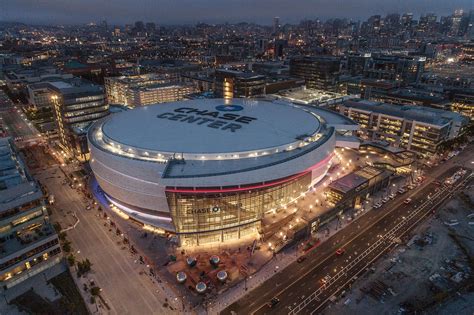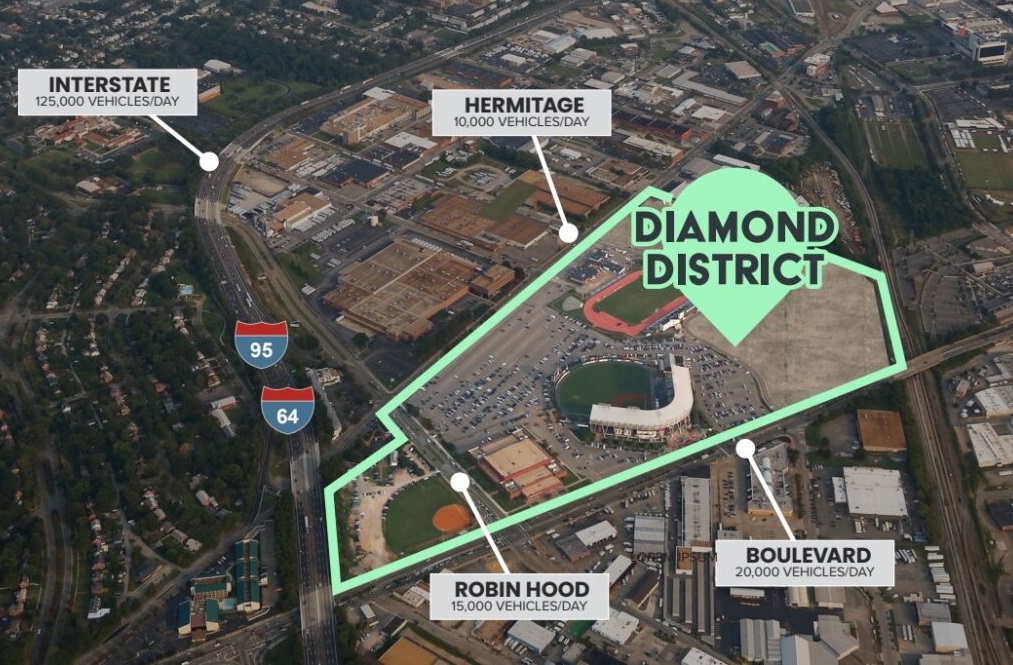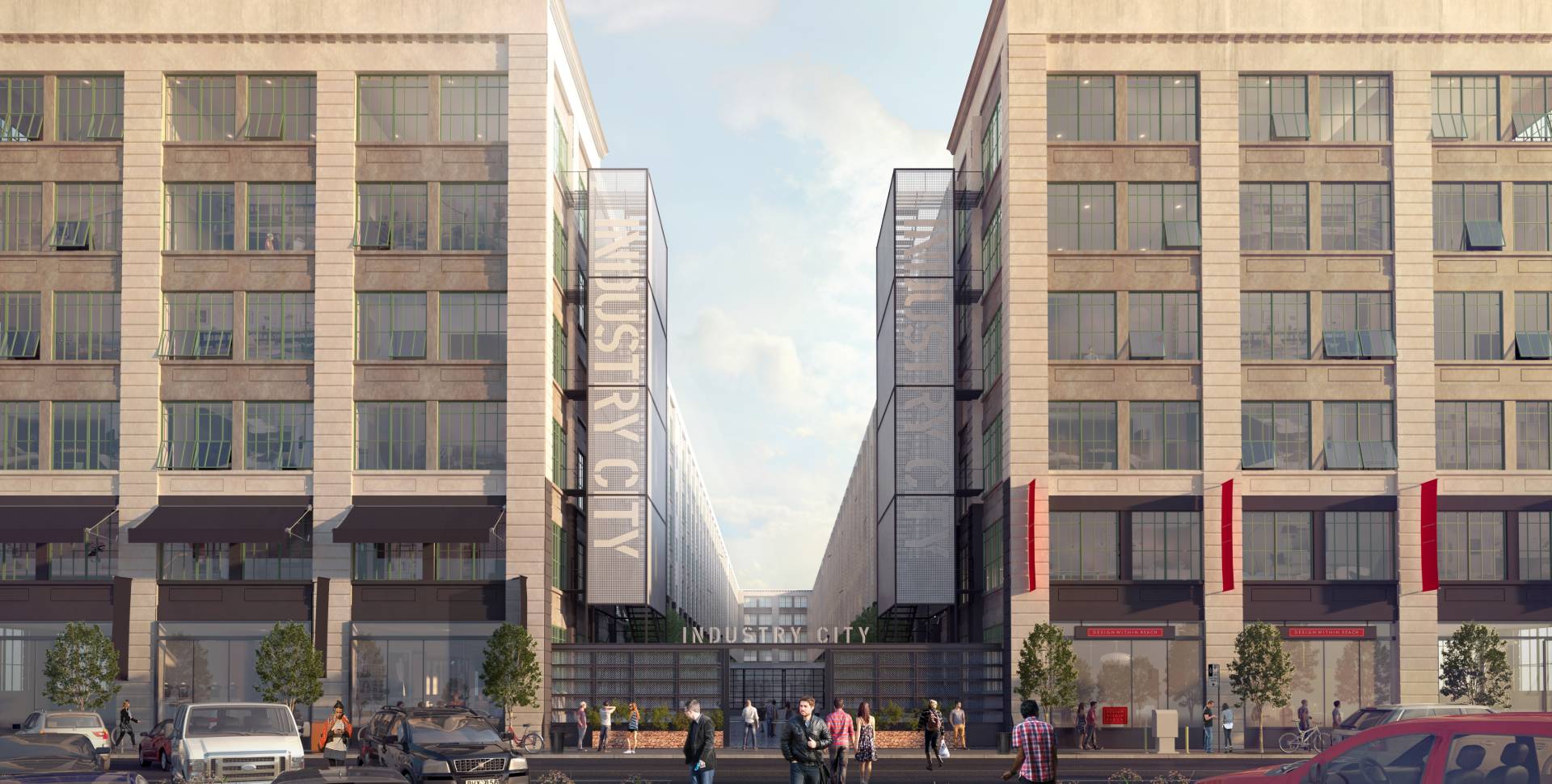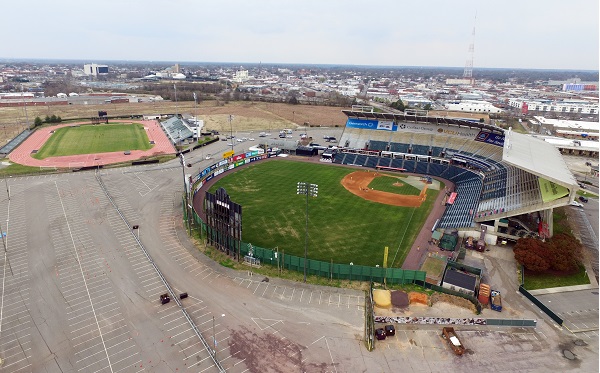
Downtown Commons in Sacramento, a mixed-use shopping and entertainment complex beside Golden 1 Center, home to the NBA’s Sacramento Kings. (Image courtesy of Machete Group)
More details are coming to light about the six development teams that remain at bat for Richmond’s Diamond District redevelopment project.
A previously unknown team, Richmond Community Development Partners, is led by Machete Group, a Houston-based venue advisory and development management firm whose sports and entertainment work has included Barclays Center in New York City, Chase Center in San Francisco, Amway Center in Orlando, and Toyota Center in Houston.
Also on the team is JMA Ventures, a San Francisco-based firm that developed Sacramento’s Downtown Commons, a mixed-use shopping and entertainment complex beside Golden 1 Center, home to the NBA’s Sacramento Kings.
Another team affiliate includes Sterling Project Development, a New York-based firm that developed the New York Mets’ Citi Field stadium and whose parent company, Sterling Equities, once owned the Major League Baseball team.

David Carlock
Machete principal and founder David Carlock has also had a hand in several notable mixed-use and entertainment developments. The Harvard grad started out at The Walt Disney Co., where he had a hand in strategic planning for Downtown Disney and its ESPN Zone restaurant and venue.
He’s also worked for Hard Rock Café and the Houston Rockets, leading operations for the NBA team’s Toyota Center after overseeing its design and construction.
The Richmond Community Development Partners team also includes several firms either based in Richmond or with a track record here. They include construction firm Gilbane, hotel management and advisory firm Retro Hospitality, architecture firm Hanbury, engineering firm VHB, marketing agency BrownBaylor, PR firm The Hodges Partnership, visual artist Hamilton Glass, and planning nonprofit Storefront for Community Design.
In an interview this week, Carlock said the team strikes a balance of local representation and out-of-town experience, not only in venue development but in lower-income housing, greenspace integration and other components sought out for the 67-acre mixed-use project that would include a replacement of The Diamond baseball stadium.
“We’ve learned from experience that these scale projects require a substantial team,” Carlock said. “We’ve gotten pretty good at developing project teams that incorporate the best of national and local. I think oftentimes you get the best results by having a combination of those things.”
Carlock named more than 20 members of the team that’s among the six that remain under consideration for the project. Those teams were asked to provide additional information after the city trimmed down its list from 15 that responded to the project’s initial solicitation. Those details are due back to the city April 25.
An evaluation panel would then select a shortlist of finalists, who would be invited to submit proposals by early June. A final selection is targeted later that month.
Carlock declined to disclose details about his team’s proposal but did discuss its approach to the project in general. He said the Diamond District project presents opportunities that require a diverse team with different specialties.

Machete Group’s portfolio includes Chase Center and adjacent mixed use in San Francisco. (Photo courtesy Machete Group)
“One of the things that’s interesting about the Diamond District is that at its scale, it presents some interesting opportunities for district-wide infrastructure solutions. Things like geothermal or (photovoltaic) array or district cooling. Those are all opportunities that can align with our strong interest and commitment to maximizing sustainability and resiliency.”
While there’s more to the project than replacing The Diamond, Carlock said the priority first and foremost is meeting the deadline set by Major League Baseball to bring all pro baseball facilities up to new standards. The project calls for a new, 10,000-capacity stadium to replace the 37-year-old Diamond, which has been deemed unfeasible for renovation.
“We understand how tight the timeline is here to deliver by opening day of 2025,” Carlock said. “Additionally, the fact that we and our team have done a lot of stadium development, we’ve been careful to fully assemble a stadium design team. If we’re lucky enough to get the nod here, our recommendation to the city is we need to hit the ground as soon as possible, to make sure we hit the date.”
Leading the team’s stadium design is architecture firm Odell, whose sports and entertainment portfolio includes BB&T Ballpark in Charlotte, home of Minor League Baseball’s Charlotte Knights. Other architects on the team include Moody Nolan, which Carlock said is the largest black-owned architecture firm in the country.
Minority business involvement is encouraged in the city’s solicitation for the project. Other minority-owned companies on Carlock’s team include engineering firm VoltAir, urban consultancy Brick & Story and the aforementioned BrownBaylor.

The 60-plus acres of the Diamond District are bordered by Arthur Ashe Boulevard, Hermitage Road, the interstate and the railroad tracks. (City of Richmond image)
Beyond the new stadium, the project is to also include a mix of development including office, residential, retail and a hotel, as well as upgrades to infrastructure such as water, sewer and roads. The residential component would consist of rental and for-sale homes that would include some units targeted to lower-income households.
For the latter, Carlock’s team includes Enterprise Community Development, the Maryland-based firm behind a trio of housing rehabs done in Richmond in recent years.
Other team members include design firm EDSA, landscape architect Rhodeside Harwell, engineering firm Stantec, placemaking consultants Biederman Redevelopment Ventures and Selbert Perkins Design, and environmental consultant Biohabitats.
Carlock noted that VHB, another engineering firm on the team, also is represented on other Diamond District teams. He said Gilbane took a lead in assembling the team, having worked with Machete on other projects.
Beyond basketball arenas and entertainment venues, Machete’s portfolio includes Major League Soccer’s new TQL Stadium in Cincinnati, and Industry City, a mixed-use redevelopment of a 35-acre stretch of Sunset Park in New York.

Machete’s portfolio includes Industry City, a mixed-use redevelopment of a 35-acre stretch of Sunset Park in New York. (Image courtesy Machete Group)
Carlock said he became aware of the Diamond District project in part from Navy Hill, the unsuccessful plan to redevelop the Richmond Coliseum, and after tasking an intern to identify new market opportunities for Machete.
“One of the markets he came back with was Richmond, Virginia, which was just not on our radar screen,” he said. “That was what initially got us focused on what was happening here, and we had a strategic partner who was involved in some of the work that was done around Navy Hill. So, we were kind of following that.”
While led primarily by out-of-town firms, Carlock said his team should not be written off for that.
“We’re almost always the out-of-town guys. We’re technically based in Houston. But the projects that we worked on and delivered, they’re all over,” he said.

The area that makes up the Diamond District includes the namesake baseball stadium and nearby Sports Backers Stadium. (BizSense file photo)
Carlock added, “Somebody who’s got some fresh ideas and perspectives that aren’t heavily influenced by what has been done in a particular market can often be helpful. At the same time, you need really significant local presence and participation. Ensuring that you have a combination of those voices, we find, gets the best outcome. We never show up thinking we have the answers.”
The other five teams that remain in contention are:
• Diamond District Gateway Partners, consisting of local real estate investment firm Capital Square, D.C.-based developers Dantes Partners and Hoffman & Associates, Maryland-based real estate firm The Velocity Cos., local architecture firm Baskervill and Missouri-based architecture firm Pendulum.
• MAG Partners, a New York City-based developer.
• RVA Diamond Partners, team members unknown.
• Vision300 Partners LLC, including developers Freehold Communities, Greenstone Properties, KDC and Spy Rock Real Estate Group; local building firm Hourigan; housing nonprofit Better Housing Coalition, construction firm Canterbury Enterprises, Shamin Hotels, YMCA of Greater Richmond, Brookfield Asset Management, and Richmond-based Sports United Ltd.
• Weller Development Co. and LMXD, consisting of Weller, a Baltimore-based developer, and LMXD, affiliated with New York-based L+M Development Partners.
Correction: Sterling Project Development developed the New York Mets’ Citi Field stadium. An earlier version of this story named another Sterling Equities affiliate.

Downtown Commons in Sacramento, a mixed-use shopping and entertainment complex beside Golden 1 Center, home to the NBA’s Sacramento Kings. (Image courtesy of Machete Group)
More details are coming to light about the six development teams that remain at bat for Richmond’s Diamond District redevelopment project.
A previously unknown team, Richmond Community Development Partners, is led by Machete Group, a Houston-based venue advisory and development management firm whose sports and entertainment work has included Barclays Center in New York City, Chase Center in San Francisco, Amway Center in Orlando, and Toyota Center in Houston.
Also on the team is JMA Ventures, a San Francisco-based firm that developed Sacramento’s Downtown Commons, a mixed-use shopping and entertainment complex beside Golden 1 Center, home to the NBA’s Sacramento Kings.
Another team affiliate includes Sterling Project Development, a New York-based firm that developed the New York Mets’ Citi Field stadium and whose parent company, Sterling Equities, once owned the Major League Baseball team.

David Carlock
Machete principal and founder David Carlock has also had a hand in several notable mixed-use and entertainment developments. The Harvard grad started out at The Walt Disney Co., where he had a hand in strategic planning for Downtown Disney and its ESPN Zone restaurant and venue.
He’s also worked for Hard Rock Café and the Houston Rockets, leading operations for the NBA team’s Toyota Center after overseeing its design and construction.
The Richmond Community Development Partners team also includes several firms either based in Richmond or with a track record here. They include construction firm Gilbane, hotel management and advisory firm Retro Hospitality, architecture firm Hanbury, engineering firm VHB, marketing agency BrownBaylor, PR firm The Hodges Partnership, visual artist Hamilton Glass, and planning nonprofit Storefront for Community Design.
In an interview this week, Carlock said the team strikes a balance of local representation and out-of-town experience, not only in venue development but in lower-income housing, greenspace integration and other components sought out for the 67-acre mixed-use project that would include a replacement of The Diamond baseball stadium.
“We’ve learned from experience that these scale projects require a substantial team,” Carlock said. “We’ve gotten pretty good at developing project teams that incorporate the best of national and local. I think oftentimes you get the best results by having a combination of those things.”
Carlock named more than 20 members of the team that’s among the six that remain under consideration for the project. Those teams were asked to provide additional information after the city trimmed down its list from 15 that responded to the project’s initial solicitation. Those details are due back to the city April 25.
An evaluation panel would then select a shortlist of finalists, who would be invited to submit proposals by early June. A final selection is targeted later that month.
Carlock declined to disclose details about his team’s proposal but did discuss its approach to the project in general. He said the Diamond District project presents opportunities that require a diverse team with different specialties.

Machete Group’s portfolio includes Chase Center and adjacent mixed use in San Francisco. (Photo courtesy Machete Group)
“One of the things that’s interesting about the Diamond District is that at its scale, it presents some interesting opportunities for district-wide infrastructure solutions. Things like geothermal or (photovoltaic) array or district cooling. Those are all opportunities that can align with our strong interest and commitment to maximizing sustainability and resiliency.”
While there’s more to the project than replacing The Diamond, Carlock said the priority first and foremost is meeting the deadline set by Major League Baseball to bring all pro baseball facilities up to new standards. The project calls for a new, 10,000-capacity stadium to replace the 37-year-old Diamond, which has been deemed unfeasible for renovation.
“We understand how tight the timeline is here to deliver by opening day of 2025,” Carlock said. “Additionally, the fact that we and our team have done a lot of stadium development, we’ve been careful to fully assemble a stadium design team. If we’re lucky enough to get the nod here, our recommendation to the city is we need to hit the ground as soon as possible, to make sure we hit the date.”
Leading the team’s stadium design is architecture firm Odell, whose sports and entertainment portfolio includes BB&T Ballpark in Charlotte, home of Minor League Baseball’s Charlotte Knights. Other architects on the team include Moody Nolan, which Carlock said is the largest black-owned architecture firm in the country.
Minority business involvement is encouraged in the city’s solicitation for the project. Other minority-owned companies on Carlock’s team include engineering firm VoltAir, urban consultancy Brick & Story and the aforementioned BrownBaylor.

The 60-plus acres of the Diamond District are bordered by Arthur Ashe Boulevard, Hermitage Road, the interstate and the railroad tracks. (City of Richmond image)
Beyond the new stadium, the project is to also include a mix of development including office, residential, retail and a hotel, as well as upgrades to infrastructure such as water, sewer and roads. The residential component would consist of rental and for-sale homes that would include some units targeted to lower-income households.
For the latter, Carlock’s team includes Enterprise Community Development, the Maryland-based firm behind a trio of housing rehabs done in Richmond in recent years.
Other team members include design firm EDSA, landscape architect Rhodeside Harwell, engineering firm Stantec, placemaking consultants Biederman Redevelopment Ventures and Selbert Perkins Design, and environmental consultant Biohabitats.
Carlock noted that VHB, another engineering firm on the team, also is represented on other Diamond District teams. He said Gilbane took a lead in assembling the team, having worked with Machete on other projects.
Beyond basketball arenas and entertainment venues, Machete’s portfolio includes Major League Soccer’s new TQL Stadium in Cincinnati, and Industry City, a mixed-use redevelopment of a 35-acre stretch of Sunset Park in New York.

Machete’s portfolio includes Industry City, a mixed-use redevelopment of a 35-acre stretch of Sunset Park in New York. (Image courtesy Machete Group)
Carlock said he became aware of the Diamond District project in part from Navy Hill, the unsuccessful plan to redevelop the Richmond Coliseum, and after tasking an intern to identify new market opportunities for Machete.
“One of the markets he came back with was Richmond, Virginia, which was just not on our radar screen,” he said. “That was what initially got us focused on what was happening here, and we had a strategic partner who was involved in some of the work that was done around Navy Hill. So, we were kind of following that.”
While led primarily by out-of-town firms, Carlock said his team should not be written off for that.
“We’re almost always the out-of-town guys. We’re technically based in Houston. But the projects that we worked on and delivered, they’re all over,” he said.

The area that makes up the Diamond District includes the namesake baseball stadium and nearby Sports Backers Stadium. (BizSense file photo)
Carlock added, “Somebody who’s got some fresh ideas and perspectives that aren’t heavily influenced by what has been done in a particular market can often be helpful. At the same time, you need really significant local presence and participation. Ensuring that you have a combination of those voices, we find, gets the best outcome. We never show up thinking we have the answers.”
The other five teams that remain in contention are:
• Diamond District Gateway Partners, consisting of local real estate investment firm Capital Square, D.C.-based developers Dantes Partners and Hoffman & Associates, Maryland-based real estate firm The Velocity Cos., local architecture firm Baskervill and Missouri-based architecture firm Pendulum.
• MAG Partners, a New York City-based developer.
• RVA Diamond Partners, team members unknown.
• Vision300 Partners LLC, including developers Freehold Communities, Greenstone Properties, KDC and Spy Rock Real Estate Group; local building firm Hourigan; housing nonprofit Better Housing Coalition, construction firm Canterbury Enterprises, Shamin Hotels, YMCA of Greater Richmond, Brookfield Asset Management, and Richmond-based Sports United Ltd.
• Weller Development Co. and LMXD, consisting of Weller, a Baltimore-based developer, and LMXD, affiliated with New York-based L+M Development Partners.
Correction: Sterling Project Development developed the New York Mets’ Citi Field stadium. An earlier version of this story named another Sterling Equities affiliate.



Appears to be likely the most qualified and experienced group for redevelopment projects/entertainment concepts. So they probably have no choice of being chosen….
Seems that way now without an article about the other contenders, but who knows, but you are correct in that that lacking any other info this team seems hard to beat in an unrigged contest.
If it’s anything like the Failed Casino “bids” These guys have no chance unless they can produce some “extra” incentives…….
With a local architect, and contractor (amongst others) on the team, and a developer with national experience and connections, this team seems like a good mix to meld the local attributes with national opportunities. Still need details on two more…
The City and these groups are wasting our money and their time. The winning bid will just get voted down anyway.
Wow! Though some of the other groups are some heavy hitters and I can’t speak to their principals — this Carlock guy is VERY impressive!! Very high level of skill in multiple dimensions! Getting people like this more involved in Richmond would likely be great for this town.